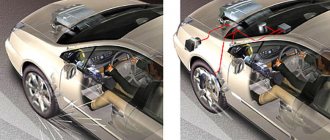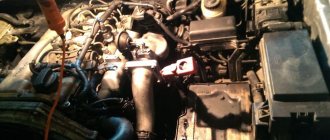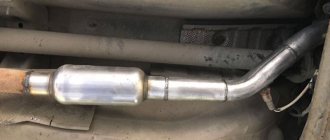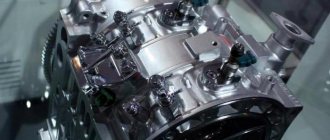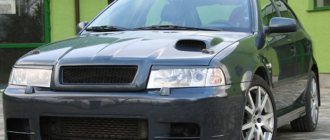What is ABS?
ABS is a system that prevents the wheels from locking when the vehicle is braking.
In cars without this system, when the brake is pressed, the wheels lock, which causes the vehicle to slide along the surface. And the ABS system is aimed at solving this problem; it relieves pressure, thanks to which the wheels begin to rotate. Thus, even in a situation where the brake pedal is constantly pressed, the process of locking and unlocking the wheels will be continuously carried out, and can occur several times per second. Today, ABS systems use the same principle as in the first developments. The leading automobile company in this field was Mercedes. Their developments with mechanical sensors were modified, and after numerous experiments and tests, non-contact sensors came to replace them. This development made it possible to quickly transfer information to the car’s control unit, and it is this principle that modern companies use.
A little about the device
I have already written a whole article about the ABS system - read it, it will be interesting. But today I want to remind you a little about the operating principle of this device.
WITHOUT ABS
A car that does not have such a system, on a slippery road (be it snow or rain), when you press the brake pedal, locks all 4 wheels, especially if emergency braking. Thus, the braking distance increases, because the contact patch between the rubber and the coating is the same - on an icy (snowy) road it will quickly become clogged with snow, but on an asphalt road (rain) it will float.
The trajectory will not be linear and, most likely, a skid will appear. Many professional drivers deliberately let the car go into a slight skid, then the pedal is released and pressed again - a kind of imitation of the operation of the anti-lock braking system.
With ABS
There are special devices installed in the wheel of a car: a gear, as well as a sensor that detects wheel locking. After this, the signal is sent to a special controller, where a decision is made to unlock one side or another.
Thus, the wheels are not completely blocked, and braking occurs more efficiently (roughly, the braking distance can be described as - dot - dash - dash - dot). Thus, the surface of the tire always substitutes a new part of the wheel, then another part is changed for braking, etc. All this happens automatically.
I think this is understandable. Now the lesson itself.
Why is ABS needed?
Even motorists with extensive driving experience and knowledge about cars are sometimes mistaken about what this system is intended for. Usually, when talking about ABS, drivers are convinced that it is necessary to reduce the braking distance, although in fact this system is needed so that the driver can control the vehicle during braking and in emergency situations. The ABS system is necessary for:
- Ensuring wheel rotation in such a way that the driver has the ability to brake and make maneuvers. After all, the necessary grip on the road surface is maintained. In the case of a car without this system, turning the steering wheel in any direction will not give any result, and the car will move in a straight path until the front wheels regain traction;
- Safe straight braking distance when the vehicle encounters a non-uniform clutch surface. For example, if one car wheel hits a wet part of the road, and the second one hits clean asphalt. A car without this system may spin out during emergency braking, because one part will brake more effectively than the other. And with the ABS system, wheel braking is regulated even when turning;
- Reducing the braking distance on flat surfaces when there is sufficient traction between the wheels and the surface;
- Prevents wheels from digging in on loose surfaces such as snow, mud, sand. ABS makes the wheels rotate, which prevents such situations;
- Improves car braking on ice on studded tires. Thanks to the locking and unlocking, the machine brakes with a short slip, which ensures a timely stop.
The ABS system provides reliable safety in any weather and on different surfaces. This system allows the driver to feel control during any braking, which is very important in emergency situations.
Machine behavior studies
Not long ago, special studies were carried out in which a car moved at a speed of 80 km/h and braked sharply to a speed of 5 km/h. This test was carried out with and without ABS, and the system turned on showed the best stopping distance. A car moving on dry asphalt, without ABS, braked 7 meters longer, and on wet asphalt 14 meters longer. In real life, this distance could be enough to save someone's life.
And if you remember that when braking sharply, cars skid on congested highways, then you become scared for the road users who are nearby at that moment. What happens if a car flies into the oncoming lane? What if there were children in the other car? The activated ABS system protects against dire consequences.
Working principle of ABS
The ABS system has evolved significantly over the years of its existence, but the basic principle of operation has remained unchanged. The most common system has sensors that monitor the speed of rotation of the wheels. An electronic unit that performs the function of controlling the operation of valves based on information received from sensors. ABS also includes valves that control the hydraulic brake line. Thus, when braking, the following happens:
- The sensor, which is located on the wheel hub, sends a signal to slow down or stop to the control unit;
- The control unit, in order to reduce the pressure and force the wheels to rotate, causes the valve to open for a short time;
- The pump included in the ABS ensures that pressure is restored after it has decreased due to valve operation.
This locking and unlocking process can occur several times per second, and the driver may feel vibration in the brake pedal.
It is also worth noting that this system can be single-channel, two-channel, three-channel and four-channel. This depends on the number of control valves and sensors. Nowadays, a four-channel system is installed on cars, as it is more efficient and takes into account the rotation speed of each wheel. By comparison, a single-channel system has the same effect on all 4 wheels and does not take into account which wheels are blocked. The principle is that each of the sensors reacts to a sharp decrease in wheel rotation. They also transmit information about the large difference between the speeds of both wheel axles. But the ABS system also takes this fact into account, so when the car turns and the speed differs, the system does not block the wheels.
On average, this system can be activated about 20 times within one second. And this is a good result, considering that a person cannot press the brake pedal so many times.
Do you need ABS?
This article is about how to drive more comfortably, with or without ABS. How to drive correctly with ABS. What to expect from a car with ABS. Do you need ABS? For a novice driver, it’s very good if the car has ABS. An experienced driver can manage without it, braking intermittently. But it is traditionally believed that ABS will cope with this better. The argument is this: in a second it manages to lock and unlock the wheels about 15 times, which is inaccessible to a person. By the way, ABS on some car models can be switched off. So it is possible to travel with or without it.
Two classic cases of braking without ABS and with ABS Case one. Autumn. The car is a VAZ. The traffic light is blinking green, there will be a yellow signal soon, but you can still drive through. There is one car ahead. She’ll definitely pass, and I’ll make it in time if I add gas, which means I won’t have to stand at red. But this only car suddenly slows down and stops (the driver decided not to go to the blinker). This was an unpleasant surprise for me. I hit the brakes hard! The wheels began to skid and the car began to drift forward. I press again. It worked! Braking has begun! I stop a meter away from the car in front of me. “Damn the dummies on foreign cars with ABS!!!” Case two. I'm driving a car with ABS, the speed is low. Ahead is a GAZelle, which for no apparent reason suddenly goes right into a side passage. But why did he stop? The passage is busy, letting someone through, but the Gazelle is big and its tail is still in my lane. I'm slowing down! The wheels scrape, but do not slow down. I hear the ABS chirping. This means the car can be driven. I calmly turn the steering wheel, without releasing the brake, and we drive around the GAZelle, driving on as if nothing had happened.”
Why is ABS needed? Whoever says that for more effective braking will be mistaken. In some conditions, ABS can even increase braking distances. ABS is needed so that during emergency braking you do not lose control of the car, in order to be able to maneuver the car and so that the car does not skid during emergency braking. Conclusion: ABS is a necessary thing, but you also need to know how to use it.
How to brake correctly with ABS? When you brake yourself, you press the brake pedal intermittently. That is, you brake either with the brake or with the engine. With ABS brakes, the technique used to press the brakes changes. You will have to press the brake pedal as hard as you can and hit it as hard as you can so that the automatic system understands that the ABS needs to be turned on. Next, you need to keep your foot on the pedal with the maximum possible effort. The harder you push, the more effective the braking will be. We don't let go of the pedal until we stop. At the same time, vibrations from the pedal will hit your feet. Wonderful! This means the ABS is turned on. On more sophisticated cars, vibrations in the brake pedal are not felt so strongly (all for driver comfort), and this does not give a clear picture of braking, which is bad in an emergency situation. The habit of pressing the brake pedal intermittently can increase the braking distance on a car with ABS!
In what cases does ABS increase braking distance? It all depends on the surface on which you have to brake. On dry and wet asphalt surfaces and compacted gravel, ABS provides a shorter braking distance.
What do you need to know when driving a car with ABS? If your ABS turns on, it means you made a mistake on the road and the car is correcting it. A definite plus: with ABS turned on, you can brake and maneuver at the same time. An undoubted disadvantage: the turned on ABS does not allow you to fully feel the car. You have to be at the mercy of the machine. Another minus: on uneven surfaces, a car with ABS may increase the braking distance.
And finally, two reviews about driving with and without ABS. “Some time ago I had an accident. Because of the ABS, they couldn’t find a stopping distance, so they had to take my word for speed, and they paid out the insurance. So now I can’t get enough of ABS, and I drive carefully, I don’t overtake milk tankers anymore!” “Surprisingly, the braking distance of a car without ABS is shorter!!! Why? It all depends on the driver’s experience and his ability to feel the car. If you have good braking skills on slippery surfaces, then by using the brake and clutch pedal and using the characteristics of the road surface, you can brake faster than a car with ABS. For example, intermittent braking, where there is ice, where asphalt or soil appears. On cars with ABS, you can no longer control this, but if you press the brake pedal, then sit and listen to how the system clicks, and if you are late with braking, hello, the bumper is in the trunk.”
This might be interesting
- On bicycles through the mountains This is a report on a journey by bicycles through the Caucasus Mountains of completely unprepared people. Read this article and you...
- Car loan. Article 5. Reviews about car loans It’s up to you to decide whether to take out a car loan or not. We publish reviews from consumers and car owners who at one time...
- Determining the quality of gasoline at a gas station The problem of low-quality fuel in Russia is quite acute, and not only people suffer from low-quality gasoline...
Pros and Cons of ABS
Despite the fact that this system is now used in cars of all classes, it has its advantages and disadvantages. The following are the advantages of ABS:
- Improving the safety of the driver and his passengers;
- Affects the service life of tires, increasing it due to the fact that during such braking the wheels rotate, reducing the pressure on the tires;
- reduction of braking distance on a flat surface;
- allows the driver to perform maneuvers when braking.
Like any other system, ABS has its disadvantages:
- A cracking sound that is heard when the system is activated;
- Ineffective system response on uneven surfaces
- Inability to brake on an icy road.
If you need to brake on ice when the system does not work, you must use the hand brake. Thus, the rear wheels will be locked and the system will automatically turn off for a while.
Despite the presence of shortcomings, this system has long been used for production cars. It provides safety, which is very important nowadays, because now drivers are not as experienced as before. Investing in a car has become a common thing for everyone, but few people know what to do in emergency situations, and thanks to ABS, such situations have become much less common.
Why you can’t “stroke” the pedal
The braking process is not always the same and depends on a number of factors: the temperature of the pads and disc, their structure, the weight of the car, climatic conditions and other things. But the main factor is the initial impulse. The stronger it is, the more effectively the car slows down.
When braking, drivers most often press the pedal lightly, and then, when an obstacle approaches unpredictably quickly, they press it harder and harder. This is the most ineffective method, in which the braking distance is almost doubled.
If you press the pads half-heartedly at high speed, they heat up and their performance decreases as the temperature rises. If at the end of the braking distance you need to slow down sharply, the hot pads and disc may fail. After several seconds of active deceleration, the temperature at the contact points of the actuators ranges from 140 to 500 degrees. If brake fluid lasts more than 3 years, there is a risk of it boiling.
Over the course of several years, water condenses and settles there, which dissolves in the working fluid. When overheated, water vapor is released, which collects in bubbles. And they collapse easily, which entails a rapid drop in the load from the pads to the brake disc.
At such a moment, it seems to the driver that the pedal has become weak and is falling down, while the car suddenly frees itself from the tense reins and runs forward. And this is dangerous, because there may be an insurmountable obstacle ahead.
Is it possible to engage reverse gear at speed and what will happen because of this? More details
What problems can there be with ABS?
Usually, there are no problems with the ABS device, in the absence of mechanical influences, because the system is very simple and reliable in operation. However, even the fact that the electronic components are protected in the form of a fuse does not save the device from breakdowns. Reasons for poor operation of the device may include:
- Constant exposure to difficult environmental conditions;
- Car battery charge status;
- Problems with the wiring in the car.
When the voltage drops to 10.5 V, the device turns off automatically and remains inactive.
To prevent spontaneous shutdown, you must follow these recommendations:
- You should not light a battery from another car, or use your own for the same purposes;
- When the ignition is running, do not disconnect the electrical connectors.
Based on this, to maintain the operation of the device, you should monitor the condition of the car. And if you suspect that ABS is distracting, you should contact specialists who will help identify the cause
How to brake with ABS
To evaluate how slippery the surface is and get the hang of how to brake with ABS , do a simple test. First, make sure there are no vehicles following you and there is enough space ahead. Then, accelerating slightly (about 20-30 km/h), sharply press the brake pedal several times. If your car is not equipped with an anti-lock braking system (ABS, also known as AB8), and the wheels are slippery, the car will skid, practically not obeying the steering wheel and slowing down inactively. If the car is equipped with ABS, then on a slippery surface the brake pedal will crackle and vibrate. This indicates that the wheels have a low coefficient of adhesion to the road surface. At the same low speed, you can sharply turn the steering wheel to the side and immediately return it to its original position. If the car follows the steering wheel, it means there is good grip on the road, but if it reacts late or doesn’t react at all, then there is ice on the road. No matter what happens, in any situation, our on-site technical assistance specialists on Moscow roads will come and provide the necessary assistance.
How to check the ABS sensor?
The ABS structure contains speed sensors; they operate based on the principle of electromagnetic induction. A coil with a special magnetic core is fixed in the gearbox, which is located in the drive axle. The ring gear attached to the hub tends to rotate parallel to the wheel. This rotation leads to a change in the parameters of the magnetic field, the response of which is the appearance of a current. The strength of this current increases in proportion to the speed of rotation of the wheels. This creates a signal that is transmitted to the control system. One of the reasons for malfunction may be a broken wire. This can be checked using a special tester, pins and a soldering iron:
- Pins that are used for repairs must be connected to connectors;
- Then use a tester to measure the resistance of the speed sensor. The normal limit values are indicated in the manual; their resistance to zero or infinity indicates the presence of a short circuit or open circuit;
- After this, you should check the wheel and resistance; in a working sensor, these indicators change.
If the sensor breaks down, you should figure out how to remove it, and then take it to a specialist for diagnostics, after which it will be clear whether it can be repaired or whether you need to purchase a new one.
Today, not a single modern vehicle can operate without an ABS system. The peculiarity of this device is its simple operating principle and efficiency. Thanks to this, many drivers can control the braking of the car in emergency situations. Therefore, it is so important to monitor the condition of the system and periodically check it with specialists.
LESSON
1) First of all, guys, you need to understand that miracles don’t happen and ABS can’t always save you. For example, in winter on an icy road with extreme braking there is not 100% protection. YES, the thorns won’t save you either. Therefore, the first rule in extreme conditions (snow, rain) is to keep an increased distance (see this lesson, everything is in detail there).
2) In such situations, I do not recommend accelerating to maximum speeds; again, this system may not save you. I repeat - miracles do not happen.
3) For those who are switching from conventional cars to variants with ABS. It just so happens that we are used to stopping the car either by coasting (we easily block the wheels - release them - block them again, etc., without causing the car to skid), or by speeding up and lowering the gear (I’m talking about winter driving). Guys, this will not work here - blocking is excluded here, because ABS will not allow you to block the wheels, the pedal will begin to resist pressing, making specific sounds. YES, and if you have an automatic, then you won’t slow down either.
4) The mistake of beginners and those who have just “moved” lies in the fact that when there is resistance to pressing the pedal, they immediately stop pressing it. Thus, only aggravating my situation, because the car did not stop. DO NOT DO THIS IN ANY CASE - IT IS IMPOSSIBLE . You need to press the pedal as hard as you can until the car stops. And the characteristic sound and resistance of the pedal should not scare you; this is how ABS works, it prevents you from locking the wheels.
5) If applied to an automatic machine, then the operating principle is as follows: we drive with our right foot on the gas pedal
– if emergency braking is necessary, simply take your foot off the gas and press the brake as hard as you can
– after the car stands up, simply remove your foot from the brake. That's it, you don't need to do anything else.
Now there is a video version of the lesson. There I tried to tell everything as simply as possible.
How to brake correctly with ABS
It happens that even a car with a working ABS is not able to slow down effectively, although the driver presses the pedal hard, and the system makes its activity known by a characteristic clicking sound. The problem may be that the surface is too slippery and the weight of the car is too large to quickly absorb high speed. In this case, even before braking begins, it is worth moving a meter and a half to the side, getting off the rolled track. Perhaps there is snow or mud there, which in this case will be beneficial and allow the wheels to grip tightly to the road surface. From the next chapter you will learn how to properly park a car in winter: how to choose a parking place, the position of the handbrake when parking and leaving the parking lot.
Intermittent or stepped braking, when the braking force is unevenly distributed between the wheels, provokes the so-called yaw, that is, the car loses directional stability. To avoid this, it is necessary to make short steering movements in the intervals between braking impulses, in no case allowing the development of a whiplash movement of the rear of the car in the opposite direction. When, with experience, the driver learns to take into account the ABS signal - a crackling sound when pressing the brake pedal, and takes the right measures - he begins to understand well how to brake correctly with ABS
. And in one of the following chapters you will find out why you need to master emergency driving techniques.
